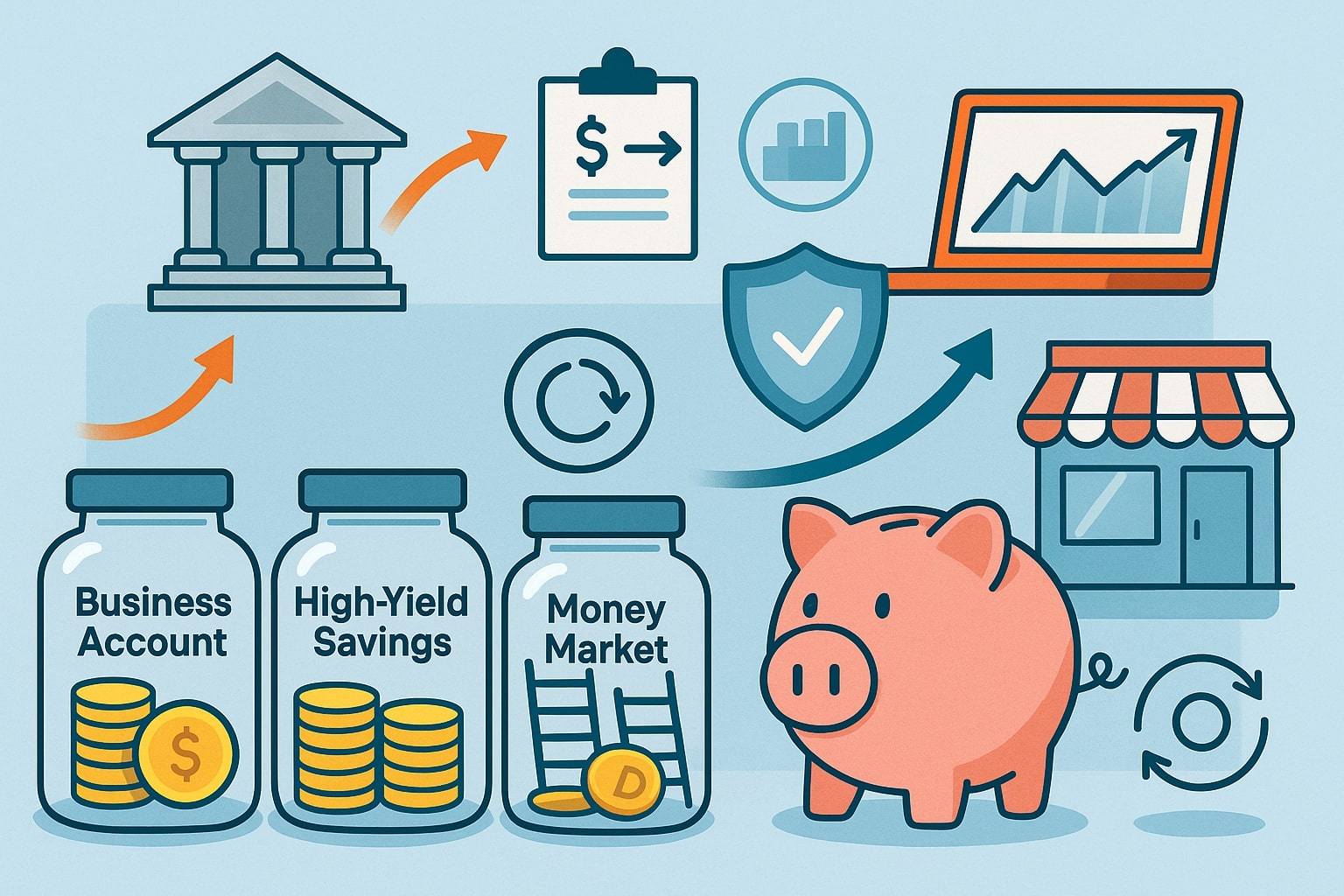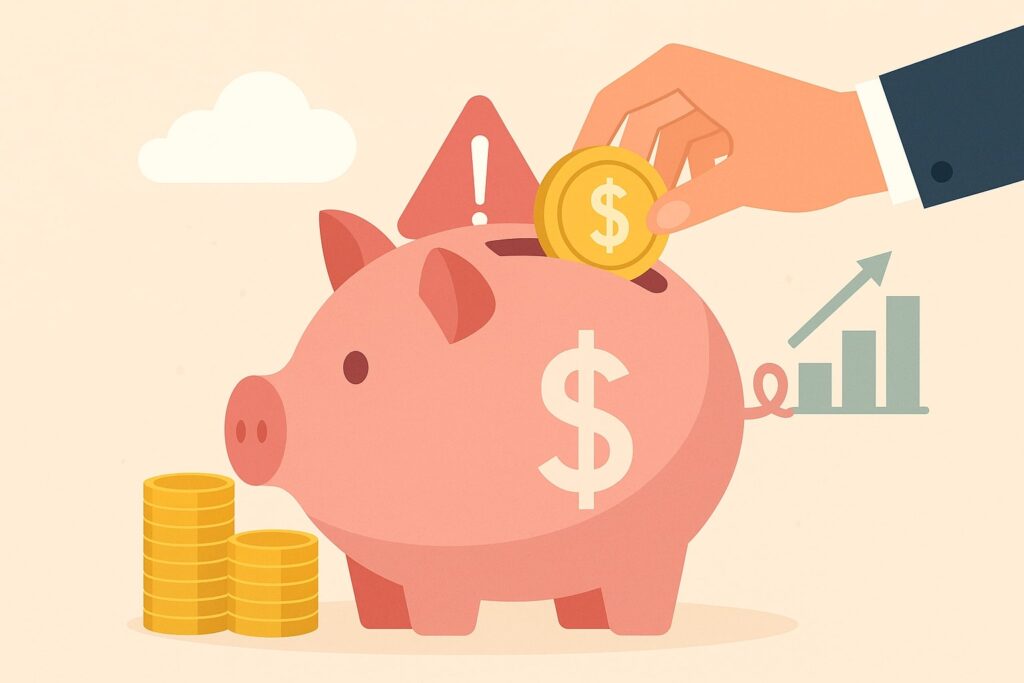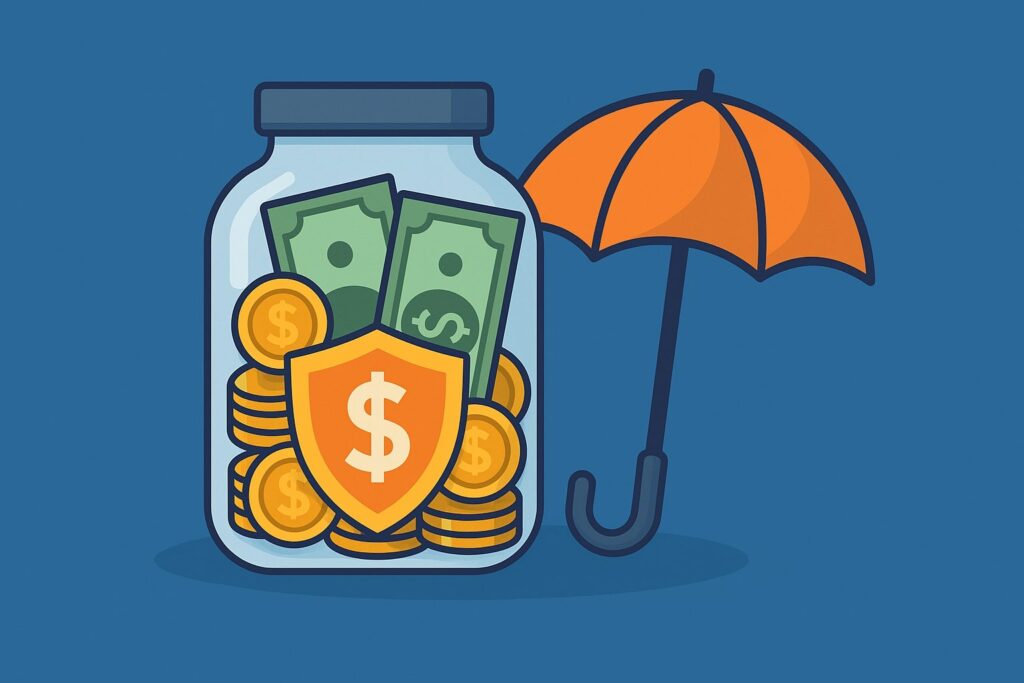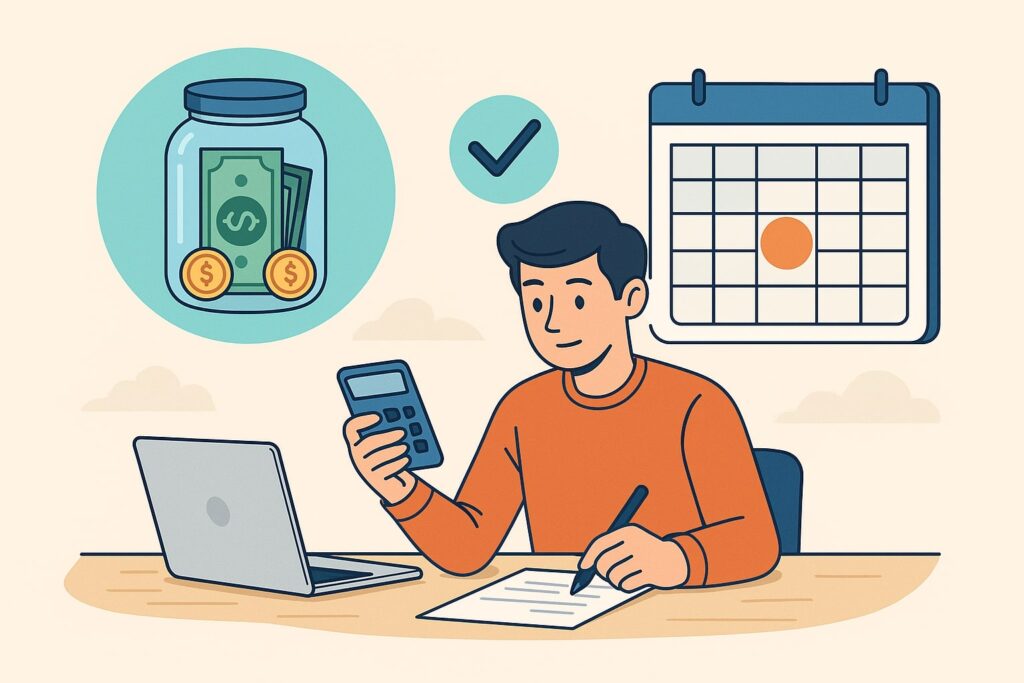
How to Build an Emergency Fund for Your Business
Building an emergency fund for your business is essential to protect against unexpected disruptions. In simplest terms, a business emergency fund is a pool of cash set aside specifically to cover unplanned expenses and cash shortfalls.
This “rainy day” fund is separate from your normal operating capital – often kept in its own business account – and is used only when unforeseen events occur (e.g. equipment failures, economic downturns, natural disasters, or sudden loss of revenue).
By having reserves on hand, businesses of all sizes (from sole proprietors and startups to large enterprises) can continue paying employees, rent, and other bills without resorting to high-interest debt.
The following guide explains why an emergency fund matters and provides step-by-step advice (with U.S.-specific examples) for building one.
What Is a Business Emergency Fund?

A business emergency fund – also known as cash reserves, capital reserves, or retained earnings – is a dedicated account holding liquid assets for unexpected costs. Unlike regular savings, these funds are set aside solely for emergencies and are usually kept separate from your day-to-day operating accounts.
In accounting terms, it may form part of the company’s retained earnings for “emergencies, investing, and opportunities”.
For example, the U.S. Small Business Administration (SBA) advises that a business continuity plan include financial reserves so you can cover immediate costs (payroll, utilities, rent, etc.) while you address a crisis.
In practice, this means keeping enough cash in a secure, interest-bearing account (such as a business savings or money market account) that can be accessed quickly when needed.
Business emergency funds are analogous to personal emergency savings, but typically larger. Since businesses often have higher monthly expenses than individuals, experts generally recommend saving a fund that covers 3–6 months of operating costs.
Some advisors now suggest aiming even higher – up to 8–12 months – given economic volatility and inflation. The exact size depends on your industry and risk exposure: businesses with seasonal sales swings or slow-paying clients may need more cushion, whereas very small freelancers might manage with a smaller sum initially.
The key is to quantify your average monthly expenses (payroll, rent, supplies, etc.) and then multiply by the number of months you want your fund to cover.
For example, if your average monthly expenses are $10,000, then a 3-month emergency fund is $30,000; a 6-month fund is $60,000. Another rule of thumb (from Bank of America) is to save roughly 10% of your annual revenue, which often works out to a similar 3–6 month buffer.
However, it never hurts to save more; larger reserves mean greater security and the ability to seize opportunities without scrambling for cash.
Why Your Business Needs an Emergency Fund

Every business faces the unexpected – from a sudden drop in sales to a critical equipment breakdown. An emergency fund provides a financial safety net so that these shocks don’t sink the business. Key reasons to build a business emergency fund include:
- Business continuity: With a funded reserve, you can keep the lights on during crises. For example, you’ll still pay rent, utilities, and staff salaries even if revenue dries up temporarily.
A U.S. Bank article explains that saving 3–6 months of expenses “won’t prevent unplanned expenses, but provides peace of mind and an ability to handle whatever comes your way”. - Avoiding debt: In an emergency without savings, businesses often rely on high-interest loans or credit cards. This can create a debt spiral. Having cash on hand lets you “be your own bank” instead of incurring unfavorable debt.
As Bench Accounting notes, a fund “enables you to avoid incurring additional debt and prevents you from using up all of your savings”. - Protecting personal assets: For small business owners and sole proprietors, mingling business and personal finances is common. A separate emergency fund keeps business problems from draining your personal bank account or retirement savings.
Live Oak Bank emphasizes that separating personal and business funds limits personal liability and helps maintain clarity, protecting both you and the company. - Managing cash flow: Businesses often experience “peaks and valleys” in income. An emergency fund smooths out these fluctuations. Even if sales slow, you can dip into reserves rather than scrambling to pay suppliers or delay payroll.
During the COVID-19 pandemic, for instance, many small firms without reserves faced closures, while others with funds could survive the downturn. - Gaining flexibility: Opportunities sometimes present as unexpectedly as crises do. If a major customer offers a bulk order or expansion opportunity, having extra cash lets you act quickly instead of turning it down.
As Bank of America points out, an emergency fund “doesn’t need to be negative” – you can also use it to capitalize on positive surprises, like ramping up production when a product goes viral.
In sum, an emergency fund is like an insurance policy. It fortifies your business against shocks and preserves your long-term strategy. Whether you’re a startup or an established firm, building this financial cushion is a prudent part of planning for the future.
Determining Your Emergency Fund Goal

The first step in building a fund is calculating how much to save. Experts commonly suggest saving 3–6 months of operating expenses. This means totaling all your fixed and variable monthly costs (rent, payroll, utilities, inventory, loan payments, etc.) and multiplying by 3 or 6.
For example, if you spend $15,000 per month, a 3-month fund is $45,000. Many advisors now lean toward the higher end: PNC Bank (March 2025) notes that “6 to 12 months of expenses can offer additional security” in today’s economy.
Similarly, a small-business guide recommends saving “six to twelve months” if possible, though it acknowledges 3–6 months as a common benchmark.
In deciding the exact target, consider factors like seasonality and cash flow. Businesses with erratic revenue or high inventory costs may want more—perhaps 8–12 months’ worth.
Benches advises that companies with slow-moving receivables or large inventories should save even more to cover worst-case scenarios.
Conversely, a solo freelancer with few fixed costs might initially aim for a smaller cushion (e.g. 3 months of personal expenses) and scale up over time.
If the full goal seems overwhelming, start with a partial target: aim first for one month’s expenses, then two, and so on. Consistency is key; saving a little each week or month will grow the fund over time.
Whether you measure by months of expenses or percentage of revenue, write down your target amount. Break it into manageable milestones (e.g. “$10K by year-end”), and incorporate this into your financial planning. Having a concrete goal makes it easier to track progress and stay motivated.
Where to Keep Your Emergency Fund

Once you know your target, choose the right place to store the money. The account(s) you use should balance liquidity (easy access when needed) with a reasonable return (earning some interest while idle).
Experts recommend keeping emergency reserves in low-risk, liquid business accounts, not in investments that could lose value or in personal accounts. Common choices include:
- Business Savings Account: These allow quick withdrawals and are FDIC-insured. The interest rates are typically low (often under 1%), but the trade-off is full access to your cash.
Bank of America and Live Oak Bank both suggest using a dedicated business savings account for the emergency fund. This keeps the money out of your regular checking but readily available for emergencies. - High-Yield Online Savings: Many online banks offer high-yield savings accounts (sometimes called high-interest savings) with rates several times the national average. For example, as of mid-2025 some accounts paid above 4% APY.
These accounts are usually FDIC-insured and allow instant transfers to a checking account. The higher rate helps your fund grow faster, making them a great option for medium-term cash. - Money Market Account: Business money market accounts offer somewhat higher rates than standard savings and may include check-writing features.
They are still liquid (though some limit transactions per month) and are FDIC-insured. A money market can be a good compromise between access and return. - Certificates of Deposit (CDs): For a portion of your fund you won’t need immediately, consider a no-penalty CD. CDs lock money for a fixed term in exchange for higher interest.
A no-penalty or short-term CD (e.g. 3–6 months) allows early withdrawal without fees, so you can still treat it as semi-liquid. Bank of America notes that a business CD “offers a fixed interest rate higher than a regular savings account,” as long as you pick one without early-withdrawal penalties. - Treasury Bills or Bonds (optional): If your fund grows very large, you might park some in ultra-safe government securities.
Short-term U.S. Treasury bills (e.g. 3-month T-bills) are nearly as liquid as cash and pay a low risk-free interest. However, this is usually more complex and unnecessary for most small businesses.
Below is a comparison of common options:
| Account Type | Liquidity | Interest Rate | Notes |
|---|---|---|---|
| Business Savings Account | High (immediate access) | Low–Moderate (≈0–1%) | FDIC-insured; use for portion of fund needed quickly. Keep emergency funds separate from daily checking. |
| High-Yield Online Savings Account | High (immediate access) | High (up to ~4–5%) | FDIC-insured; online banks like SoFi, Ally, and others often offer top APYs. Good for growth while keeping funds accessible. |
| Money Market Account | Medium (some limits) | Moderate (1–3%) | Usually FDIC-insured; may include limited check-writing. Offers better rates than standard savings. |
| No-Penalty Certificate of Deposit (CD) | Low to Medium (locked) | High (3–5%+) | Fixed term for higher yield. Use no-penalty or short-term CDs so you can withdraw in a pinch. |
| Business Checking Account | Very High (pay bills) | Very Low (~0%) | Keep minimal balance for operations. Not ideal for holding most of your fund due to near-zero interest. |
By diversifying this way, you reduce risk. For instance, you might keep 1–2 months of expenses in a regular savings/checking for immediate needs, and the rest in higher-yield vehicles. Allianz Trade recommends spreading cash across several assets to mitigate any single point of failure.
The short-term reserve should remain in a savings account or money market for instant access, while any longer-term excess can be laddered into CDs or very short bonds to earn more. Just ensure that enough cash stays liquid to cover your defined emergency period.
Step-by-Step: Building Your Emergency Fund
With goals and accounts decided, follow these steps to build and maintain your fund:
- Calculate Your Required Fund Size. List all fixed and variable monthly expenses (rent, salaries, utilities, loan payments, inventory purchases, etc.). Multiply this by 3 (or more) to set a target.
Use last year’s financial statements or a budget forecast to refine these numbers. The Bank of Blue Valley (Live Oak Bank) advises using your cash flow statements to “determine monthly expenses” such as utilities, payroll, inventory and healthcare. That way you have a data-driven target for 3–6+ months of cover. - Open a Dedicated Account. Create a separate business account (or accounts) just for emergency savings. It can be at your existing bank or a different one.
The key is segregation: keeping the fund out of your regular checking and away from other “noise.” As PNC Bank advises, “separating your emergency fund from other cash accounts is key” to avoid spending it on non-emergencies.
Ideally choose a high-yield savings or money market account (online banks often offer attractive APYs) so your balance grows faster while staying liquid. - Set Up Automated Transfers. Schedule regular transfers (e.g. weekly or monthly) from your checking into the emergency account. Automation makes saving consistent.
Bench Accounting and American Express both recommend automatic transfers so you “build your savings regardless of what else is going on”. Even if it’s a small fixed amount (say 5–10% of revenue), over time it adds up.
You can start with an amount you can afford, then gradually increase the transfer as revenue grows. For example, if you get a tax refund or a larger payment, immediately allocate it to the fund. U.S. Bank suggests using bonuses, rebates, or any cost-saving windfalls to top off the fund. - Reinvest Cost Savings. Look for ways to trim expenses and funnel the savings into your fund. Automating routine tasks, negotiating supplier discounts, or reducing overhead (like energy use) frees cash.
The U.S Bank explicitly says to “reinvest money savings from cost-cutting measures” into the emergency fund. For example, if you save $200 by switching utility providers, transfer that $200 into your reserve.
Over time, cost-efficiency improvements can significantly boost savings without impacting operations. - Use Budget Line Items. Treat the emergency fund as a regular budget item. Allocate a percentage of income each month for it. Live Oak Bank recommends labeling it like any other expense; for instance, budgeting a fixed 10–20% of profits toward the fund.
Similarly, the U.S. Bank suggests adding a “miscellaneous” line in the budget for unforeseen (e.g. 20% of income) to ensure you consistently set aside some cash. This embeds saving into the financial routine. - Monitor and Rebalance Regularly. As your business grows or costs change, revisit the fund target. Every year (or after major changes) recalculate your expenses and adjust the fund size.
For example, if you hire more staff or expand to a new location, your operating expenses rise, so you should increase the reserve accordingly. Conversely, if costs fall, you might reallocate some cash for other uses (though reinvesting in the fund is usually safer).
PNC Bank calls this “rebalancing” – periodically ensuring your cushion still matches current needs. Keeping tabs on the fund balance and your business budget ensures the fund remains sufficient. - Maintain Discipline – Only for Emergencies. Define clearly what counts as an emergency expense. Common examples include major equipment breakdowns, business interruption, lawsuits, or sudden market declines.
Avoid dipping into the fund for routine or non-essential costs. Some companies even implement a formal policy: e.g. withdrawals from the emergency fund require multiple approvals.
Live Oak Bank notes that having the fund “out of reach for everyday use” and dedicated to disasters helps it serve its purpose. And if you do use the fund, replenish it as soon as possible – treat the used amount as a new goal to save back. - Consider Backup Funding Options. While cash is king, don’t rely on it alone. U.S. Banks and others advise arranging secondary sources like a business credit card or line of credit ahead of time.
These can cover very large or unexpected expenses beyond your cash cushion. For example, use a low-interest business credit card for an urgent equipment repair if the fund is insufficient.
But remember: credit and loans should be a last resort, as they incur debt. The emergency fund’s whole point is to avoid borrowing under duress. Use credit lines judiciously – preferably to complement (not substitute) your fund.
Below is a quick checklist summarizing these steps:
- Determine expenses and set a goal (e.g. 3–6+ months).
- Open a separate high-yield business savings/money market account.
- Automate contributions (fixed transfers or % of revenue).
- Save windfalls and cost savings (tax refunds, bonuses, efficiency gains).
- Define emergency criteria to avoid misuse.
- Review annually and rebalance the fund as needed.
Following these steps patiently will grow your fund over time. Even starting small, “consistency is key” to building financial resilience.
Emergency Funds for Different Types of Businesses
Freelancers and Solopreneurs
Self-employed individuals and freelancers essentially run their own small businesses, so they also need a fund – often one that blends personal and business needs.
Since freelancers typically rely on a single income stream and may have irregular payments, many advisors suggest aiming for a larger cushion (6–12 months of personal living and business expenses).
Ensure you separate the fund from your personal checking: using a dedicated savings account (even if technically held by you personally) helps track and protect these reserves.
A general rule is to treat your freelance income as “business revenue” and save as above – start with what you can afford and grow the fund with every payment received.
Small Businesses and Startups
Small businesses and startups often have tight cash flow. However, as many sources emphasize, failure to prepare financially is preparing to fail. Even if you’re a new company with slim margins, begin with a modest fund and build it along with your growth.
SBA-backed lenders and small business coaches typically recommend 3–6 months of expenses as a starting target. In the U.S., small business resources (like SBA, SCORE or local Small Business Development Centers) often include emergency savings in their continuity planning advice.
If capital is scarce, prioritize automating savings and consider guaranteed sources like SBA microloans or grants for cash-flow support during development – but treat those as complements to (not replacements for) your own fund.
Large Enterprises and Corporations
Large businesses generally have more sophisticated treasury management and may hold much larger reserves. Public companies routinely keep cash on hand for acquisitions and downturns (in fact, global corporate cash reserves exceed trillions of dollars).
The principles are the same: maintain liquidity in safe accounts. However, large firms may diversify reserves across multiple accounts and instruments (e.g. bank accounts, commercial paper, treasury bills) and often set policies for maximum allowable leverage.
They may also combine emergency savings with formal lines of credit and insurance programs. Even so, CEOs of big companies echo the advice given to small firms: treat capital reserves as a top priority for continuity and strategic flexibility.
Regional Considerations (U.S. Focus)
This guide leans on U.S. practices. In the United States, many national and regional banks offer business savings products tailored for emergency funds.
For example, Bank of America recommends keeping your emergency fund in a business savings account or a no-penalty CD. PNC Bank and U.S. Banks advise high-yield savings or money market accounts as ideal vessels.
Live Oak Bank (a U.S. commercial lender) even advertises business savings accounts with interest rates multiple times the national average. Generally, look for FDIC-insured products (including online banks, credit unions, or local community banks) to ensure protection.
In addition to banks, U.S. small businesses can tap government-backed guidance: the SBA’s Business Continuity Planning resources stress emergency reserves as a key part of any continuity plan.
Industry associations and nonprofits (SCORE, NFIB, chambers of commerce) often provide worksheets or coaching on budgeting for reserves. While specific savings tools may vary, the underlying advice is consistent: set aside cash in stable accounts.
Avoiding Common Mistakes
- Mixing funds: Don’t skip opening a separate account. Keeping emergency cash in your regular checking makes it tempting to spend on normal bills.
- Using credit first: Avoid treating your line of credit as the emergency fund. Loans and cards should be backed up, not the primary plan.
- Underfunding: Waiting for “enough revenue” can leave you exposed. Start small if needed – even $1000 is better than zero.
- Lack of liquidity: Don’t tie all your money in investments or long-term vehicles. Keep at least some cash in an instantly accessible account.
- Not adjusting: If your business grows or inflation rises, adjust your target. Many owners forget to rebalance, leaving their fund inadequate over time.
By avoiding these errors, you ensure the fund serves its purpose when every dollar matters.
Frequently Asked Questions
Q: What exactly counts as a business emergency?
A: Generally, any unplanned event that forces you to spend cash to keep operating. Common examples include equipment failures, computer or cyber incidents, natural disasters, sudden loss of a major client, lawsuits, or an economic downturn.
In short, an emergency is a significant negative event you didn’t budget for. (By contrast, planned expenses like taxes or known slow seasons are not “emergencies.”)
Q: How much should I put in a business emergency fund?
A: It varies, but a typical guideline is 3–6 months’ worth of operating expenses. Some advisors now suggest 6–12 months for extra security. Another rule of thumb is about 10% of annual revenue.
Ultimately, calculate your actual monthly costs and multiply by the cushion you feel comfortable with. Even a smaller fund (e.g. one month) is a good start if you build it up over time.
Q: Where should I keep my emergency fund money?
A: Use safe, liquid business accounts. A separate business savings or money market account is best. Many business owners also use high-yield online savings accounts (with FDIC insurance) to earn more interest.
You can also ladder a portion into short-term no-penalty CDs for higher returns. The key is that the cash must be quickly accessible (within days, not months). Avoid risky investments or accounts that could impose withdrawal penalties when an emergency hits.
Q: Should my business be debt-free before I start saving?
A: No. Business financial priorities are not the same as personal ones. EntreLeadership (Ramsey) advises that even if you have business debt, you should allocate a portion of profits to savings concurrently.
Typically, you pay yourself a modest wage and then split excess profits between debt payment and capital reserves. In other words, you can save and pay debt at the same time. Delaying savings until all loans are cleared is risky because emergencies can happen any time.
Q: What if I can’t save 3–6 months right away?
A: Start small and build up. Experts stress that some savings are better than none. For instance, Bench Accounting says it’s fine that most small businesses can’t save that much at first – just begin with whatever you can.
Even dedicating a fixed small amount each week or month, and increasing it when business is good, will accumulate over time. Just be consistent, automate where possible, and celebrate reaching interim goals (like 1 month, 2 months, etc.).
Q: Are there alternatives to an emergency fund?
A: The primary alternative is external credit (a business credit card or line of credit) and insurance. In practice, however, these should supplement rather than replace a cash fund.
Business credit cards or a small line of credit can cover unexpected costs (U.S. Bank recommends having one for emergencies), but they incur debt that you must repay. Insurance policies (property, interruption, liability) also provide relief in disasters.
But a cash reserve offers instant, debt-free liquidity. Wise businesses use all these tools together: keep cash on hand and maintain credit/insurance as backstops.
Q: How often should I review my emergency fund?
A: At least once a year, or whenever your expenses change significantly. Every annual budgeting cycle, revisit your calculation (Step 1 above). If your rent went up, you hired staff, or you launched a new product line, you’ll need a larger fund.
Live Oak Bank suggests reevaluating your cushion at least annually as expenses rise with growth. Even if nothing changes, check the balance and interest: you may want to move money into a higher-yield account or ladder a CD. Keeping the fund aligned with reality ensures it remains effective.
Conclusion
An emergency fund is a financial safety net that keeps your business afloat when a crisis hits. By systematically saving 3–6 (or more) months of expenses in separate, accessible accounts, you give your business the agility to handle disruptions without panic.
All businesses – from freelancers and startups to large corporations – benefit from such reserves. Follow a disciplined plan: calculate your needs, open a dedicated account (preferably high-yield), automate contributions, and review regularly. Combine your cash savings with smart use of credit and insurance for maximum resilience.
Building a business emergency fund may take time and sacrifice, but the payoff is peace of mind and continuity. As one guide puts it, this fund acts like a safety net, enabling your business to “keep carrying on” when trouble comes.
In an unpredictable economy, having liquid reserves could be the difference between weathering a storm and closing your doors. Start today by setting aside your first dollars – your future self (and business) will thank you.